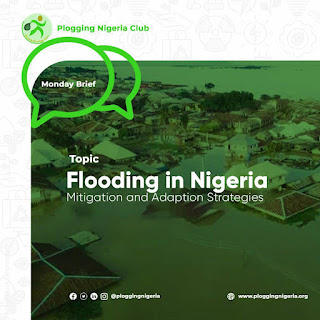"Why do you have to act quickly during a flood?"
Me: "Because it's an emergent sea."
I pretty much think that would crack you up. If I fail, I guess there's nothing really funny about flooding when it won't stop taking lives and damaging our properties unless we begin to act. It's sad how many of our fellow citizens now have something in common with Fishes— both groups swim in their homes.
From the Federal Government Data, the 2022 Nigeria floods displaced over 1.4 million people and killed over 603 people, and injured more than 2,400 persons. About 82,035 houses have been damaged, and 332,327 hectares of land have also been damaged.
We've seen enough "Shege '' already, from the 2012 floods and this recent flooding has overthrown it as the GOAT or perhaps DOAT— (most) Devastating Of All Times.
Flood insurance might look like a way out but would you rather lose things you could prevent?
That ushers us to certain strategies we can engage in to mitigate flooding.
Mitigation Strategies for Flooding
It is commonly said that "prevention is better than cure".
To mitigate simply is to prevent something from happening. By Mitigation strategies, we mean the various things that can be done to reduce the occurrence of flooding.
It's the "a stitch in time saves nine" kind of strategy.
- Take Climate Action
In our Previous article, it was established that cases of flooding this severe are caused by water release caused by climate change-induced Rainfall.
If the world continues to generate carbon footprints and greenhouse gases, the climate will continue to change and we'll continue to experience the effect of climate change on rainfall. In other words, Aluta Continua for flooding.
Also, due to global warming and climate change, Sea levels are increasing and so are the risks of flooding in coastal areas, as they are the closest to these seas and rivers and are on the path of the water flow when the rivers go overbank.
Since climate change is a contributing factor to this issue, the first step towards preventing flooding will be to take action to combat climate change such as reducing our activities that generate so many emissions.
- Establish Infrastructures for Mitigation
The construction of dams and reservoirs to hold excess water by diverting water from rivers during periods of overflow, riverbank protection, construction of levees and spillways, appropriate drainage systems, and dredging of some of the major rivers are some ways through which we can curb the effect of flooding.
For example, the Dasin dam, had it been completed, could have performed this role. Holding excess water from Cameroon and diverting it for irrigation, thus fostering climate-smart agriculture.
Flood walls and/or Sea Walls can be useful and they're constructed out of concrete or steel to control the flow of flood waters and prevent the flooding of a specific area. An example is the Great Wall of Lagos.
- Preserve Coastlines and Flood plains
Another factor that leads to being at risk of flood is encroaching on the coastal shorelines. Many cities are at risk of flooding because of their "Urban development".
Every member of biodiversity has its natural habitat. By encroaching on the coastal shorelines in our bid for urban development, plant organisms e.g mangroves, coral reefs, and other biodiversity species that retain excess water, reduce the high-velocity impact of water flow, are destroyed and water flows freely to inundate the communities.
In other words, as much as possible, building along coastlines should be avoided.
However, not all environmental crises can be prevented.
The question is, how do we move from here?
Adaption Strategies for Flooding
Firstly, we must acknowledge the collective nature of this problem. Flooding is not just an environmental issue, it is an economic, social, educational, and health threat. This means all sectors must collaborate to help citizens adapt to the effects of the flood.
When homes are destroyed, lives are lost, education is put on hold, and businesses crash, it is more than just an issue for the "Climate change" department.
The Government must adapt to the emergency budget required to help impacted citizens.
Effective adaptation to rising flood risk requires a diversified approach of interventions, which includes an early warning system, educating homeowners and renters before moving into a new home to determine if it is a floodplain area, protecting wetlands by preventing development in those areas, creating a comprehensive mitigation plan to reduce the risk of flood damages to property and life.
For individuals, it's true "There's no place like home", but in situations like severe flooding, home is where you're safe. Evacuating your home or location (for the period of flooding, at least) will save your life and your properties.
For example, NEMA issued warnings to some states about the possibility of flooding.
Unfortunately, waiting on Authorities to do more than spread information might not be the best option for us. It is unlikely that the Authorities who didn't help residents evacuate before the flood, will keep residents safe during the flood or help them rebuild after the flood.
For the sake of life and hard-earned properties, we must act for ourselves because truly, we only have ourselves
If we don't play our roles, I'm afraid we might have to start learning how to breathe underwater.
– Dolapo Johnson











.jpeg)






0 Comments